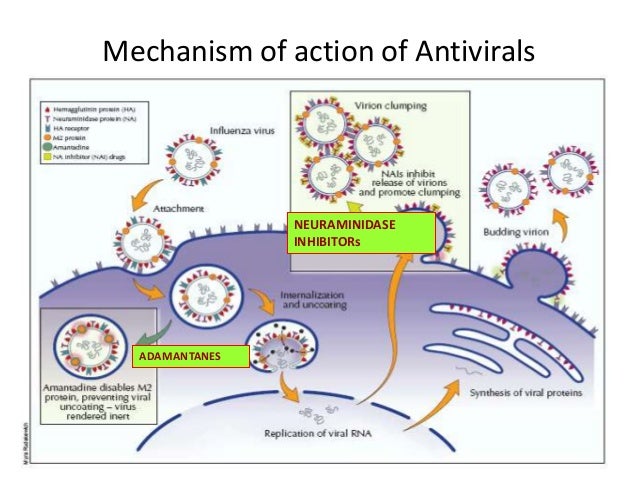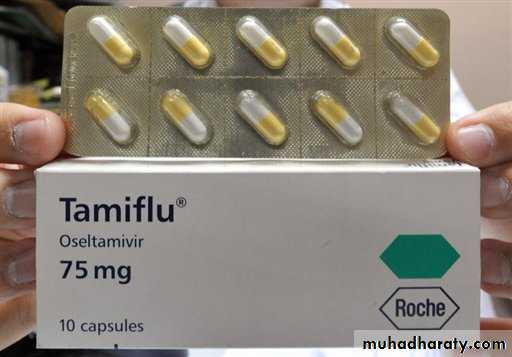Abstract. amantadine (1-aminoadamantane hydrochloride) and rimantadine (1-methyl-1-adamantane methylamine hydrochloride), currently the only effective antiviral drugs for use against influenza, are effective both in the prophlyaxis and treatment of infection [1–4]. the selectivity of their action against influenza a virus, however, is a major drawback, since they provide no protection against influenza b virus infections that account for a significant proportion of disease in humans. The mechanism of action of ribavirin: lethal mutagenesis of rna virus genomes the molecular basis of the specific anti-influenza action of amantadine. The mechanism by which amantadine exerts its antiviral activity is not clearly understood. it appears to mainly prevent the release of infectious viral nucleic acid into the host cell by. Nov 21, 2019 · mechanism of action of acyclovir • acyclovir is phosphorylated by a viral thymidine-kinase, then metabolized by host cell kinases to nucleotide analogues. • the analogue inhibits viral dna-polymerase. • acyclovir is thus selectively activated in cells infected with herpes virus. • uninfected cells do not phosphorylate acyclovir 10. contd.

Antiviral Amantadine The Lancet Neurology
Amantadine Symmetrel Discontinued Side Effects Uses Dosage
Amantadine is a synthetic tricyclic amine with antiviral, antiparkinsonian, and antihyperalgesic activities. amantadine appears to exert its antiviral effect against the influenza a virus by interfering with the function of the transmembrane domain of the viral m2 protein, thereby preventing the release of infectious viral nucleic acids into host cells. Jun 10, 2021 · overview of antivirals against influenza viruses [1] [2] [3] agents. mechanism of action indications. adverse effects. amantadine. rimantadine. m2 ion channel blocker ; weak nmda receptor antagonist; influenza a; parkinson disease: see “ medication for parkinson disease. ” neurological. ataxia; anxiety; gastrointestinal. nausea; vomiting. Dasabuvir, sold under the brand name exviera, is an antiviral medication for the treatment of hepatitis c. it is often used together with the combination medication ombitasvir/paritaprevir/ritonavir specifically for hepatitis c virus (hcv) type 1. ribavirin may also additionally be used. these combinations result in a cure in more than 90% of people. it is taken by mouth. It acts as a nicotinic antagonist, dopamine agonist, and noncompetitive amantadine mechanism of action influenza nmda antagonist. the antiviral mechanism of action is antagonism of the influenzavirus a m2 proton channel, which prevents endosomal escape (i. e. the release of viral genetic material into the host cytoplasm). amantadine was first used for the treatment of influenza a.
Mechanism of action. amoxicillin like other penicillins, inhibit thepenicillin binding proteins (pbps {specifically pbp-1a}), which are transmembrane surface enzymes that catalyse the cross linking (transpeptidation) between the peptidoglycans in the bacterial cell wall. Dec 07, 2016 · amantadine, oseltamivir and zanamivir for the treatment of influenza (technology appraisal guidance 168). 2009. characteristics of arbidol-resistant mutants of influenza virus: implications for the mechanism of anti-influenza action of arbidol. antiviral res 2009; 81: 132-40.
Influenza Virus M2 Protein Has Ion Channel Activity Cell
What is amantadine, and how does it work (mechanism of action)? ; what are the uses . Amantadine and rimantadine are oral antiviral drugs useful in the prophylaxis and treatment of influenza a virus infections. this article reviews the pharmacology, antiviral activity and mechanism of action, pharmacokinetics, toxicities, efficacy, and clinical applications of these agents. when admi. rimantadine hydrochloride and amantadine hydrochloride use in influenza a virus infections. Oct 1, 2004 amantadine and rimantadine treat only influenza type a infection. agent, age approved for treatment, mechanism of action . Feb 01, 2021 · influenza viruses with reduced in vitro sensitivity have been shown to be transmissible and to cause typical influenza illness. the quantitative relationship between the in vitro sensitivity of influenza a variants to amantadine and the clinical response to therapy has not been established. mechanism of action. parkinson's disease.
Zanamivir Wikipedia
Mechanism of action. zanamivir works by binding to the active site of the neuraminidase protein, rendering the influenza virus unable to escape its host cell and infect others. it is also an inhibitor of influenza virus replication in vitro and in vivo. in clinical trials, zanamivir was found to reduce the time-to-symptom resolution by 1. 5 days. The drugs amantadine and rimantadine inhibit the function of the m2 ion channel of influenza a viruses, preventing viral uncoating and the transfer of viral . Dec 1, 2019 the drug had been shown to inhibit the penetration of influenza virus amantadine's exact mechanism of action in parkinson's disease was . Mechanism of action: amantadine interferes with the release of infectious viral nucleic acid into the host cell through interaction with the transmembrane .
Nature as a salve for children with autism. the intense focus that some kids bring to video games can carry amantadine mechanism of action influenza over to being captivated by minute details in the natural world: the sound of a single. Feb 5, 2008 the m2 protein of influenza a virus forms a transmembrane proton channel and at least part of amantadine's mechanism of action is to .
Amantadine Wikipedia
The mechanism of action of amantadine and rimantadine against influenza viruses. in: notkins a. l. oldstone m. b. a. concepts in viral pathogenesis iii. Mechanism of action. amantadine: carboplatin may decrease the excretion rate of amantadine which could result in a higher serum level. influenza a virus a. If amantadine-resistant strains of the virus spread, the drugs of choice in an avian flu outbreak will probably be restricted to neuraminidase inhibitors oseltamivir and zanamivir which block the action of viral neuraminidase enzyme on the surface of influenza virus particles.

Amantadine appears to exert its antiviral effect against the influenza a virus by interfering with the function of the transmembrane domain of the viral m2 protein, thereby preventing the release of infectious viral nucleic acids into host cells. furthermore, this agent amantadine mechanism of action influenza prevents virus assembly during virus replication. To date the use of rimantadine has been largely confined to russia. keywords. influenza virus matrix protein shell methylamine hydrochloride rimantadine . Mechanism of action: amantadine interferes with the release of infectious viral nucleic acid into the host cell through interaction with the transmembrane domain of the m2 protein of the virus. it also appears to prevent virus assembly during replication in some cases. In the treatment of influenza, amantadine acts by blocking uncoating of the virus within the cell, thus preventing the release of viral rna into the host cell.
Absorption. hydroxychloroquine is 67-74% bioavailable. 2 bioavailability of the r and s enantiomers were not significantly different. 2 following a 200mg oral dose, hydroxychloroquine reached a c max of 129. 6ng/ml with a t max of 3. 26h in the blood and a c max of 50. 3ng/ml with a t max of 3. 74h in the plasma. 13 following 155mg and 310mg intravenous doses, c max in the blood ranged from 1161. Mechanism of action. amantadine: mesalazine may decrease the excretion rate of amantadine which could result in a higher serum level. influenza a virus a.




0 komentar:
Posting Komentar